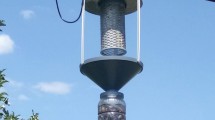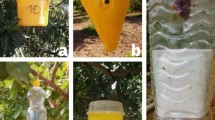Abstract
A two-year field study was carried out to evaluate the efficacy of mass-trapping of the codling moth, Cydia pomonella (L.) (Lepidoptera: Tortricidae), using newly designed light trap in reducing fruit damage in apple orchards. In both years (2020 and 2021), experiments were conducted in two apple orchards, one of which was located in Antalya (Elmalı) province and the other was located in Isparta (Senirkent) province (southwestern part of Turkey). For each of the two years, the study orchards were divided into two equal parts (plots), separating from each other by a guard row; in one of them (termed ‘light trap plot’), newly designed light trap was tested and the traps were placed 30 m apart from each other along the outer rows of the plot just above the plant canopy (≈4 m from the ground), using galvanized metal poles. In the other plot (termed ‘conventional plot’), conventional control system, based heavily relied on the use of synthetic insecticides, was applied for comparison. In weekly trap checks in the light trap plot of each orchard, total number of adult C. pomonella caught in each trap was recorded. The effectiveness of mass-trapping in reducing fruit damage was evaluated by comparing the percentages of weekly infestation in apple fruits (examining 100 randomly selected fruits on the trees) and the percentages of damaged fruits at harvest in both plots of each orchard. The results demonstrated that mass-trapping of adult C. pomonella using newly designed light trap was effective in reducing fruit damage in both years. Considering the yearly averages, in both 2020 and 2021 significantly lower fruit damages were observed in the light trap plot of the orchards in both Antalya (9.6 and 7.8%) and Isparta (8.8 and 7.3%) than in their conventional plots (10.2 and 9.4% in Antalya, 7.5 and 9.1% in Isparta, respectively). Mass-trapping adult C. pomonella using newly designed light trap seems to be an effective tool for the integrated pest management (IPM) of C. pomonella in apple orchards.




Similar content being viewed by others
Availability of data and materials
All data are within the manuscript and supplementary materials.
Code availability
Not applicable.
References
Abbas M, Ramzan M, Hussain N, Ghaffar A, Hussain K, Abbas S, Raza A (2019) Role of light traps in attracting, killing and biodiversity studies of insect pests in Thal. Pak J Agric Res 32:684–690
Al-Abbar F, Hajjar MJ, Jamal M (2010) The side-effect of some insecticides used in apple orchards in Syria on the life stages of egg parasitoid Trichogramma cacoeciae Marchal (Trichogrammatidae: Hymenoptera). Arab J Plant Protec 28:85–90
Anonymous (2008) Codling moth. https://a-z-animals.com/animals/codling-moth/. Accessed 5 September 2022
Anonymous (2021) Codling moth: Integrated pest management for apples. http://omafra.gov.on.ca/english/crops/facts/codling.htm. Accessed 5 September 2022
Antignus Y (2000) Manipulation of wavelength-dependent behavior of insects: an IPM tool to impede insects and restrict epidemics of insect-borne viruses. Virus Res 71:213–220
Barnes MM (1991) Codling moth occurrence, host race formation, and damage. In: van der Geest LPS, Evenhuis HH (eds) Tortricid pests: their biology, natural enemies and control. Elsevier, Netherlands, pp 313–328
Calkins CO, Faust RJ (2003) Overview of areawide programs and the program for suppression of codling moth in the western USA directed by the United States Department of Agriculture–Agricultural Research Service. Pest Manag Sci 59:601–604
Celik H, Unlu L (2017) Determination of adult population development and infestation rates of coldling moth [Cydia pomonella (L.) (Lep.: Tortricidae)] in apple orchards in Beyşehir (Konya). Harr J Agri Food Sci 21:266–278
Delpuech JM, Allemand R (2011) Side effects of fungicides on the abundance and the species diversity of the natural populations of Drosophila and their hymenopterous parasitoids in orchards. Phytoparasitica 39:429–435
Erler F, Bayram Y (2021) Efficacy of mass trapping of tomato moth, Tuta absoluta (Meyrick, 1917) (Lepidoptera: Gelechiidae), using a new-designed light trap in reducing leaf and fruit damages in greenhouse-grown tomatoes. J Plant Dis Protect 128:1177–1185
Gallo JA (2013) Codling moth trap. Foreign Patent Documents. https://patents.google.com/patent/US8424239B1/en. Accessed 10 Feb 2023
Gang MA, Chun-Sen MA (2012) Differences in the nocturnal flight activity of insect pests and beneficial predatory insects recorded by light traps: Possible use of a beneficial-friendly trapping strategy for controlling insect pests. Eur J Entomol 109:395–401
Grigg-McGuffin K, Scott IM, Bellerose S, Chouinard G, Cormier D, Scott-Dupree C (2015) Susceptibility in field populations of codling moth, Cydia pomonella (L.) (Lepidoptera: Tortricidae), in Ontario and Quebec apple orchards to a selection of insecticides. Pest Manag Sci 71(2):234–242
Isci M, Ay R (2017) Determination of resistance and resistance mechanisms to thiacloprid in Cydia pomonella L. (Lepidoptera: Tortricidae) populations collected from apple orchards in Isparta Province. Turkey Crop Prot 91:82–88
Jiang D, Chen S, Hao M, Fu J, Ding F (2018) Mapping the potential global Codling moth (Cydia pomonella L.) distribution based on a machine learning method. Sci Rep 8:13093. https://doi.org/10.1038/s41598-018-31478-3
Jones V (2020) How to effectively manage codling moth. Washington State University Tree Fruit Research Center. http://treefruit.wsu.edu/article/how-to-effectively-manage-codling-moth/?print-view=true. Accessed 28 Jan 2023
Khaghaninia S, Mohammadi SA, Sarafrazi AM, Haddad-Iraninejad K, Ebrahimi E, Zahiri R (2014) An analysis of seasonal dimorphism in codling moths, Cydia pomonella, from Iran using geometric morphometrics. Bull inSect 67:43–50
Kitching IJ, Cadiou JM (2000) Hawkmoths of the world. Nat. History Museum, Lond. Cornell Univ. Press, London
Kovanci OB, Pehlevan B (2015) Combined use of mating disruption with early season insecticide sprays for control of codling moth in Turkey. In: International scientific symposium on “Modern Horticulture-Achievements and Perspectives”, Chisinau, Moldova, 1-2 October 2015, vol. 42, pp. 300–305
Mamay M, Yanik E (2013) Determination of population development and infestation rates of codling moth [Cydia pomonella (L.) (Lepidoptera: Tortricidae)] by using different sampling methods in Şanlıurfa province. J Agri Sci 19:113–120
Murray M, Alston D (2020) Codling moth mating disruption. Utah State University Extension. https://extension.usu.edu/pests/research/codling-moth-mating-disruption. Accessed 28 January 2023
Myburgh AC (1976) Sex ratios in adult populations of codling moth (Lepidoptera: Olethreutidae). J Entomol Soc South Afr 39:117–120
Oztemiz S, Kuden A, Nas S, Lavkor I (2017) Efficacy of Trichogramma evanescens and Bacillus thuringiensis var. kurstaki in control of Cydia pomonella (L.) in Turkey. Turk J Agri Forest 41(3):201–207
Rivkina OG, Sexton SB, Il'Ichev A (2020) The black light trap for monitoring of codling moth Cydia pomonella L. (Lepidoptera: Tortricidae) in pome fruit orchard under mating disruption. In: XXI international congress of entomology (ICE), Iguassu Falls, Brazil, Vol. 2
Schumacher P, Weyeneth A, Weber DC, Dorn S (2008) Long flights in Cydia pomonella L. (Lepidoptera: Tortricidae) measured by a flight mill: Influence of sex, mated status and age. Physiol Entomol 22:49–160
Shimoda M, Honda K (2013) Insect reactions to light and its applications to pest management. Appl Entomol Zool 48:413–421
Sigsgaard L, Herz A, Korsgaard M, Wührer B (2017) Mass release of Trichogramma evanescens and T. cacoeciae can reduce damage by the apple codling moth Cydia pomonella in organic orchards under pheromone disruption. Insects 8(2):41
Singh SK and Bambawale O (2012) Light trap for managing insects. Indian Council of Agricultural Research, Unit Natinal Center for Integrated Pest Management. http://www.google.com/patents/WO2012098484A1?cl=en. Accessed 11 Feb 2023
Tomaš V, Šimić D, Mihaljević I, Dugalić K, Viljevac-Vuletić M, Vuković D, Zdunić Z, Barić B, Brmež M (2018) The efficiency of biological control treatments of codling moth (Cydia pomonella L.) on three different apple varieties. Appl Ecol Environ Res 16:1293–1303
Torres CF, Rodríguez MA, Blas-Lavandero B, Fuentes-Contreras E (2015) Body mass and wing geometric morphology of the codling moth (Lepidoptera: Tortricidae) according to sex, location and host plant in the region of Maule, Chile. Cienc Invest Agrar 42:397–406
UC-IPM (2015) Agriculture: apple pest management guidelines. Codling moth (Cydia pomonella). https://www2.ipm.ucanr.edu/agriculture/apple/Codling-moth. 17 Sept 2022
Acknowledgements
The authors thank KEKOVA Energy, Agriculture, Industry and Trade Ltd. Co. (Etiler, Evliya Çelebi Cd. No:7/F, 07010 Muratpaşa/Antalya, Turkey) for providing light traps, and the owners of both apple orchards for providing study area.
Funding
Not applicable.
Author information
Authors and Affiliations
Corresponding author
Ethics declarations
Conflict of interests
The authors declare that they have no conflict of interest.
Ethics approval and consent to participate
Not applicable.
Consent for publication
Not applicable.
Additional information
Publisher's Note
Springer Nature remains neutral with regard to jurisdictional claims in published maps and institutional affiliations.
Rights and permissions
Springer Nature or its licensor (e.g. a society or other partner) holds exclusive rights to this article under a publishing agreement with the author(s) or other rightsholder(s); author self-archiving of the accepted manuscript version of this article is solely governed by the terms of such publishing agreement and applicable law.
About this article
Cite this article
Erler, F., Tosun, H.S. Mass-trapping the codling moth, Cydia pomonella (L.) (Lepidoptera: Tortricidae), using newly designed light trap reduces fruit damage in apple orchards. J Plant Dis Prot 130, 795–807 (2023). https://doi.org/10.1007/s41348-023-00735-7
Received:
Accepted:
Published:
Issue Date:
DOI: https://doi.org/10.1007/s41348-023-00735-7




